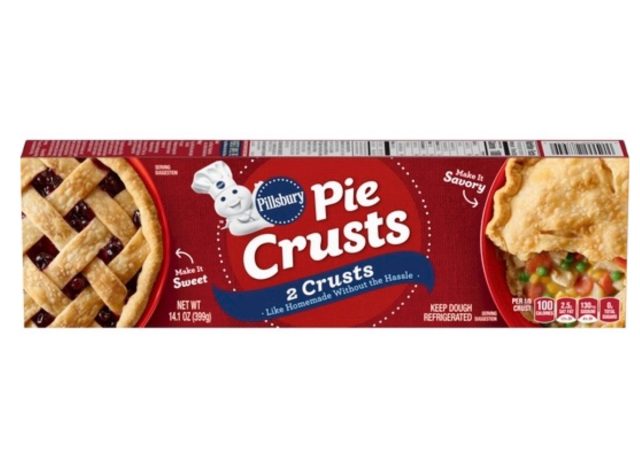
As a general rule, the month of December is a time when sweets rule the world. The holiday season is synonymous with sugary treats, and chief among them are pies—especially homemade pies.
But, not all pies are created equal, and not everyone has the time or baking know-how to create a fresh butter, flour, and salt mixture, roll it out thin, and carefully place it in a tin, along with mixing up the filling for said pastry treat. It's just not sustainable for those of us with, you know, full-time jobs, children, nonstop household chores, and of course, social obligations like holiday parties.
So, yes, store-bought pie crust is going to come out at one point or another for most people during this incredibly busy season. And that's totally okay! In that generous holiday spirit, we asked some of the best bakers we know to give recommendations on specific brands of store-bought crust, as well as what to look for when selecting your purchase, regardless of vendor. Check out their tips, tricks, and crust insights below.
Marie Callender's Frozen Pastry Pie Shells

Trung Vu, chef-instructor of pastry and baking arts at the Institute of Culinary Education, is one of the foremost experts on pastry and baking in the country, in fact, he's responsible for teaching new bakers how to go from eager young hobbyists to industry professionals. His very first tip? Make sure you can see the crust you're about to purchase, which is part of why Marie Callender's crusts are a great option for buyers. The see-through packaging shows the bulk of the crust, which comes in a handy pack of two in case there are any issues—or, in case inspiration strikes, and you want to make more than one sweet treat).
"When selecting store-bought pie crust, the first consideration to make is whether to use one that is already rolled out and lined in an aluminum pie pan, or the frozen folded dough packet," Vu explains. "If you're buying pie crust that is already rolled out and in the pan, you want to be able to see it—so see-through packaging is mandatory. You don't want to get home and find that the crust is broken when you open it."
Another great feature of this particular pie crust is that it doesn't contain lard, which is what can make some pies off-putting for vegetarians, who obviously avoid ingredients like animal fats. For Marie Callender's recipe, the crust is both vegetarian and kosher, which is helpful if you're baking for people with special allergies or restrictions. Vu notes that after checking the crust's appearance, he then looks at the ingredients list. While selecting a crust without lard is important for vegetarian cooking, a better gauge of flavor will be if the crust in question uses saturated fats or oils, which are unsaturated.
"Ideally it would have the same ingredients I would use if I was making it from scratch, namely butter, lard, vegetable shortening, or a mix of these fats," says Vu. "Butter is the ultimate fat in terms of flavor, but lard (which will make it not vegetarian) is the king of flakiness. Vegetable shortening is a suitable replacement for lard if you are vegetarian. If there is no butter, or if it is listed after other fats, it won't likely taste as good. If the fats used are unsaturated (saturated fats like the three mentioned are solids at room temperature) such as soybean or canola oil, these won't likely produce a flaky crust."
Pillsbury Ready-To-Bake Pie Crust

Daphane DeLone is the pastry chef for Los Angeles mainstay Connie + Ted's, one of the few restaurants in West Hollywood that has remained a go-to destination for over 10 years. Though the restaurant is a seafood-focused spot, it's also become very well known for DeLone's otherworldly Sweet Potato Whoopie Pies that turn up around the holidays. DeLone is also responsible for making any baked goods that show up on the menu from scratch, so she's busy whipping up breads, crackers, cakes and pies even when it's not the holiday season.
Like most professional bakers, she only makes homemade pie crusts as home, but her choice for store-bought is tied to the nostalgia of what her mom would use when she was growing up—Pillsbury Ready-To-Bake Pie Crust. "As a child, my mom would use this one, so my favorite store-bought pie crust would be the Pillsbury ready-to-bake pie crusts," DeLone says. "With these, you can roll them out and shape them as you wish, so that it appears to be homemade. It has a nice flaky texture too!"
One of the reasons this crust has such a good texture is because it's made with lard, which creates that beautiful flakiness. Just make sure you let guests know this pie isn't vegetarian when you're serving it to friends and family.
Belmont Deep Dish Pie Crust

Pie crusts don't have to be expensive to be delicious, says Sarah Fennel, the mastermind behind the blog Broma Bakery, which has been going strong since 2010. Though Fennel also cites the ease of making your own dough from scratch, and offers some tips on how to do just that below, her go-to for a store-bought brand is from the popular discount grocer Aldi. "I love Aldi's Belmont Deep Dish Pie Crust," Fennel says. "It has a deeper bottom, meaning more space for glorious filling! Plus, the price can't be beat. Everyone is going to have their own opinions, so I think the best thing to do is experiment to find the one you like the most. I personally prefer pie crusts that are pre-rolled into their container, as it means there is one less prep step involved!"
Trader Joe's Pie Crust

One last option is to get some pre-made dough that's not already placed into a pan, like the trusty frozen option from Trader Joe's. Rolling it out yourself can lead to a flakier, more homemade feel, according to DeLone, and the chance to shape the dough in your own pan is another way to control how the pie turns out.
"If you're using dough that has been folded, defrost it gently and fully in the refrigerator overnight and unfold it carefully to minimize chances of cracking," adds Vu. "I prefer this over the pre-lined dough in aluminum pans as I favor baking my pies in cast iron. Cast iron absorbs and retains heat very well, as opposed to aluminum, glass, or light colored pie pans. This leads to a browner and more flavorful crust, especially the bottom side that you can't see." One final word of wisdom from Vu: "Pro tip: When I don't get as much color as I want on the underside of a pie or tart, I put it on the stovetop and monitor it over low heat until it achieves the color I want."
Wholly Gluten Free Pie Shells

Okay, here's one that we don't need a professional baker to tell us it will really work for a certain segment of the population—the gluten avoiders! Just because wheat flour isn't in your future (for whatever reason) doesn't mean pies have to be a thing of the past. Wholly Gluten Free's crust is both gluten-free and vegan, and prepared free from all of the following allergens: casein, egg, soy, peanut, tree nut, sesame seed, and corn. This one works for those with the trickiest allergies and will still make you look like a superstar, homemade pie baker. It also comes in the transparent packaging that bakers recommend.
Mrs. Smith's Oronoque Orchards Deep Dish Pie Crusts

Again, this crust doesn't need a specific baker recommending it because, despite the small brand name, it topped multiple lists around the internet for its "buttery aroma" and for "color, texture, and flavor" that rivals name brands, but just at half price. It's a budget pick, like the Aldi option, but also works for vegan and kosher diets, as it uses soybean oil instead of butter or lard and is still cited as having a very flaky quality.









